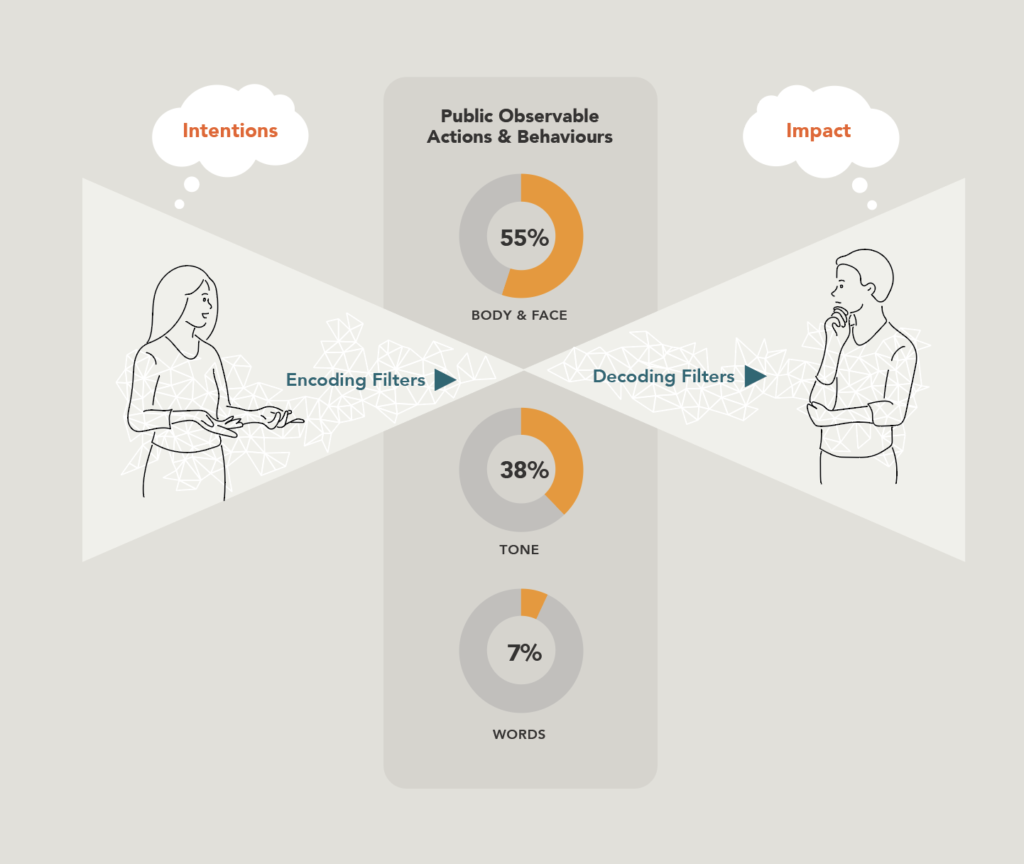One of the places we get in trouble when building an inclusive culture is discerning intent from impact.
- Intent – is what you intend to convey through your words and actions.
- Impact – is how your words and actions make others feel.
In an ideal world, our intent and impact would line up perfectly. What we mean to say or do would be interpreted exactly as we intended. We would take actions and say words intended to communicate that everyone belongs and is appreciated and respected. And the people on the receiving end of these words and actions would feel like they are appreciated, respected, and belong.
Unfortunately, in real life things don’t always work out that way. One party may do or say something with a positive intent – only to have the receiver feel hurt or offended.
Intent does not equal impact. Here’s why.
We each see the world through our own filters.

The sender communicates their message through the lens of their culture, assumptions, histories, preferences, past experiences, and physical state. The receiver filters the message through THEIR lens – which may be very different. This creates an interpersonal gap.
Example of intent <> impact
People often run into intent vs impact when they try to use humour to connect with their colleagues. For example, someone notices that their coworker is very conscientious and detail-oriented when it comes to managing projects. They make a joke about how they “must be OCD.” The intent of the joker is to make a connection by sharing a laugh. They may even see their comment as a compliment.
However, the receiver has heard this before – including times when the intent was NOT positive. They interpret it as an observation or even accusation that they have a mental illness. Or worse, perhaps they DO have a mental illness and are hurt by the joke. The intent was positive. The impact was negative.
This is an example of what we call a microaggression. A micro-aggression is a statement, action, or incident regarded as an instance of indirect, subtle, or unintentional discrimination against members of a marginalized group. If you can imagine what it would be like for the person on the receiving end – it feels like a death by a million cuts – even if some of those cuts weren’t intended.
Our role as leaders in these situations is to be aware of these microaggressions, notice when they are happening, and then take action. So what can be done? How do we close the gap?
Closing the gap
Resolving intent vs impact situations can be tricky because nobody is necessarily wrong. We’re each just acting in the way that we have learned growing up in our respective cultures. From this, we have our own definitions and interpretations of what things mean. Responsibility for closing the gap falls on both sides.
As the sender of the message:
- Share your intent freely and often: don’t assume that the other person will intuit it.
- Inquire into the impact of your words and actions on others: if in doubt, ask.
- Own your impact: accept responsibility and apologize for negative impact, even if your intent was positive.
- Clarify, but don’t defend your Intent. Defending your intent amplifies the negative impact and negates any apology you offer.
As the receiver of the message:
- Notice and share the impact that the other person’s words and actions are having on you:
- remember that the sender can’t read your mind and hasn’t had the lived experiences that you have had.
- Assume positive intent: most people don’t intend to be hurtful.
- If you find assuming positive intent to be challenging, inquire into their intent. Ask: did you mean this?
Closing the gap is an ongoing process – it’s something we’ll be doing all the time. Remember that we all bring our own assumptions, histories, cultures, and preferences to our interactions. We need to clarify our intent and own our impact. Inclusive leadership is about clear communication, recognizing that we are all different, and being OK with that.

